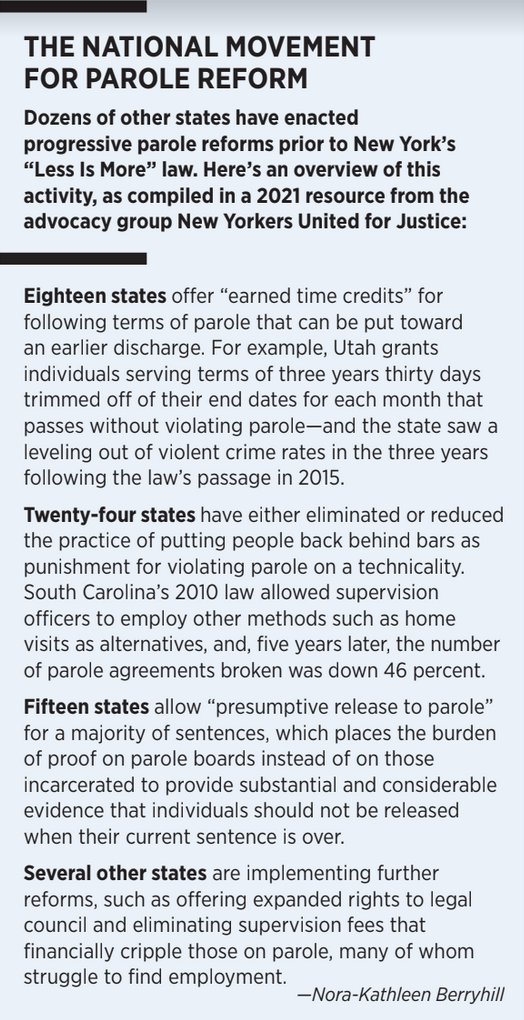By: Victoria Law via The Progressive Magazine
In 2007, Derek Singletary was twenty-two years old and rebuilding his life after being incarcerated for a drug charge.
He had enrolled in vocational school and was hoping to join the carpenters’ union.
“I wasn’t running the streets,” he recalls in an interview with The Progressive. “I was focused on doing the things I needed to do for myself legally.”
Then, in spring of that year, Singletary was fifteen to twenty minutes late returning to his home in Syracuse, New York, violating the 9 p.m. curfew set by the terms of his parole. He was arrested and imprisoned for ninety days.
Those ninety days uprooted his entire life—and future plans.
“I didn’t want to try anymore,” Singletary says. “I didn’t feel like trying to fit into society was the right thing for me, especially not when running the streets would provide [me] with money in my pocket and more or less result in the same fate. I couldn’t justify doing things legally if I was still being punished [for violating curfew] as if I had broken the law.”
Singletary was arrested again in 2010 and sentenced to twenty years in prison for manslaughter. Looking back on that night, Singletary muses, “Who knows where I would be if I would’ve been able to get into the carpenters’ union? I seem to be getting it right now, I could’ve gotten it right then.”
In 2012, shortly after she was paroled after twenty-seven years at Bedford Hills Correctional Facility in Bedford Hills, New York, for kidnapping and murder, Donna Hylton was threatened with the same disruption. She had been approved to live in Providence House, in nearby New Rochelle, which provides transitional housing for women and children. Soon after settling in, she visited her adoptive parents. It was the first time she saw or spoke with them since her incarceration. Throughout her childhood, her parents had been abusive but, she tells The Progressive, during her imprisonment, she had matured, healed, and ultimately forgiven them.
Hylton decided to move in with her parents, which her parole officer, after some wrangling, approved. But when her parents again became abusive, she knew she had to leave. Her parole officer threatened to send Hylton back to prison on a parole violation if she did not find approved housing within twenty-four hours. Fortunately, Sister Mary Nerney, a nun who provided services to women at Bedford Hills, let Hylton move in with her, avoiding this fate.
Hylton’s and Singletary’s experiences are not unusual. Across the country, people on parole risk arrest and imprisonment for technical parole violations, such as missing an appointment with a parole officer, staying out past curfew, or changing residences. None are actual crimes, but for those on parole, they can lead to re-imprisonment.
Twenty-four states limit incarceration for technical parole violations. New York was not among them until recently. Before then, it had the nation’s second-highest number, after Illinois, of parolees returned to prison for technical violations. These revocations have played a key role in keeping prisons packed.
Between 2014 and 2018, the number of people in New York City’s jails dropped by 21 percent. The number of people jailed for technical violations, however, increased by 15 percent. Those jailed for technical parole violations are not eligible for bail or release on recognizance (the promise that they will return to court). Instead, they must remain behind bars awaiting a hearing by an administrative judge who decides whether the violation merits re-imprisonment.
In 2018, New York State sent almost seven times as many people on parole to prison for technical violations (7,492) as it did for new crimes (1,101). People imprisoned for technical parole violations comprised 39 percent of those sent to prison that year.
In 2019, the Independent Commission on New York City Criminal Justice and Incarceration Reform found that 20 percent of the city’s jail population were people accused of parole violations. Nearly 90 percent of these were people of color.
Those jailed for technical parole violations can spend up to 105 days in jail awaiting a hearing. But even a shorter jail stay can mean losing a job or housing and placement in school, training, or treatment programs. Parents risk losing custody of their children.
But now, thanks in large part to the organizing efforts of people who have faced re-imprisonment for technical parole violations, New Yorkers are no longer revoked simply for missing an appointment, arriving home late, or failing a drug or alcohol test.
And that’s due to an innovative state law known as “Less Is More.”
In 2018, the Columbia Justice Lab released a report detailing how parole violations had become a pathway to prison.
Yonah Zeitz, director of advocacy at the Katal Center for Equity, Health, and Justice, explains that the report’s title, “Less Is More in New York,” is short for “less community supervision equals more community safety.”
Devante Perez (center) and Betsy Ramos (right) from the organization A Little Piece of Light rally outside Rikers in February 2022.
Research findings have shown that more intense supervision leads to higher rates of incarceration. The report recommended shorter parole terms, incentivizing good behavior with earlier discharge, requiring graduated (non-prison) sanctions in lieu of re-imprisonment, and capping the number of days a person could be incarcerated for a technical parole violation.
One of the Katal Center’s founding campaigns was the 2016 #CLOSErikers campaign, which pushed to shutter Rikers Island, New York City’s island-jail complex. But this would require decreasing the number of people held there on any given day, including the hundreds jailed on technical parole violations.
Advocates including Hylton, who was then working at Katal, helped lawmakers draft a bill to eliminate re-imprisoning people for technical parole violations. From his prison cell in Elmira, Singletary also worked to make the bill a reality.
In March 2018, two months after the report’s release, Singletary and his wife, Emily NaPier Singletary, founded Unchained, based in central and western New York. They threw themselves into the campaign to make lawmakers adopt Less Is More.
In prison, Singletary gathered stories from the incarcerated men around him about their parole experiences. He also reviewed early versions of the bill in his prison cell, and mailed his edits to NaPier Singletary to incorporate into later drafts.
Singletary’s input, his wife says, led to some key provisions, including requiring that those accused of parole violations be granted hearings in local courts. A previous draft had provided such hearings only for technical violations, which would have meant those accused of violating parole for allegations of new crimes had to have their hearings in jail, where they were unable to call witnesses, have legal representation, or even have family present. “Derek raised a really strong objection that having two separate locations set up two systems of justice,” she says.
Another added provision restricted a practice known as “delinquency time,” which allows parole officers to extend the parole sentence based on previous violations. “Let’s say someone misses curfew in February [and] a parole appointment in March, but the officer made a note and did not re-incarcerate them,” NaPier Singletary explains. “In April, they test positive for marijuana. The parole officer would go back to the first violation noted in the file and include that in the charges at the hearing. That earliest date would be the delinquency date. They don’t get credit for completing parole starting on that date.”
Hylton, who has since been discharged from parole, asked several women still at Bedford, including her friend Pamela Smart, about being re-incarcerated for parole violations. Smart, a longtime advocate for the incarcerated, is a member of the Incarcerated Liaison Committee, tasked with representing incarcerated people in discussions with prison administrators.
“I went from unit to unit spreading the word about what I was looking for,” Smart says in an interview from Bedford Hills. “Women started to come forth and give me their information, or other women passed names along due to them having heard my message.” Hylton then shared this information with those drafting the bill.
In December 2018, the Less Is More bill was introduced in the state legislature, and advocates got to work trying to push it into law. In reaching out to other organizations and individuals, they managed to garner some surprising supporters, including eight current district attorneys, four sheriffs, and one chief of police.
Hylton went door-to-door throughout New York City, handing out flyers about the bill and urging people to contact their legislators. “We met family members who were impacted,” she recalls. “They didn’t understand why their family members, who were working and seemed to be doing well, were found in violation and sent back to prison.”
In upstate New York, NaPier Singletary marshaled people who were or had been on parole, as well as people with loved ones in prison, to meet with local legislators. Supporters of the bill from all over the state also converged on the capitol for lobby days. Formerly incarcerated people shared their stories with lawmakers and their staffers.
On the last lobby day in January 2020, NaPier Singletary brought a carload of formerly incarcerated people from Syracuse to Albany. They met with lawmakers, including a number of progressive Black and Latinx legislators, mostly from the New York City area. On the drive home, people were exhausted, but also elated and optimistic, realizing the power of grassroots organizing. “It was a pretty joyful experience,” NaPier Singletary says. “People were really eager to do it again.”
And then, in March 2020, the coronavirus hit the United States.
Jails and prisons quickly became hotbeds of COVID-19 transmission. On Rikers Island, fifty-three-year-old Michael Tyson, the first incarcerated person in New York City confirmed to die of the virus, had been jailed on a technical parole violation.
By then, Hylton had formed her own organization, A Little Piece of Light, to work with women, girls, and gender fluid people impacted by the criminal justice system. Bedford, which has a prison nursery where mothers can keep their babies for the first year and a half of their lives, is also where all pregnant women in New York are sent to serve their sentences. Hylton and Smart gathered their names and contacted legislators; eight pregnant women were ultimately released. One had been incarcerated for the technical parole violation of using illegal substances. “With Less Is More,” Hylton notes, “she wouldn’t have been there in the first place.”
Anthony Maund, who spent twenty-two months in prison for violating parole, also helped generate support for the bill. Upon his release, he signed up to volunteer on the campaign’s website. It was the first time he had participated in any type of political organizing.
“Katal took me in, showed me how to do organizing, and showed me how my voice is important,” he says. At first, Maund simply attended online meetings. Then he reached out to his own legislators, Crystal Peoples-Stokes and Timothy Kennedy, and set up a virtual meeting. “I was sweating and shaking,” he recalls. But the lawmakers were “very receptive. They really listened.” They signed onto the bill almost immediately.
In June 2021, lawmakers finally voted on the bill. The night before, NaPier Singletary and other advocates were on the phone until past midnight negotiating proposed changes to ensure that the bill would not be watered down. On the day of the vote, NaPier Singletary drove to Maryland to celebrate her birthday with friends. She pulled over several times at fast food restaurants to watch the proceedings on her phone.
The bill passed. That night, when Derek called, she shared the good news.

In September, NaPier Singletary was in New York City for the bill’s signing. She brought Singletary’s grandmother, who had raised him. “That was really meaningful for her to be there since he couldn’t be—and for her to see what he had accomplished,” she says. At the end of the ceremony, Assembly Speaker Carl Heastie handed her the pen he used to sign the bill. “I want you to give this to Derek,” he told her.
That won’t be possible until Derek Singletary is home, as people in prison are not allowed to receive pens from family members. But when he is released, possibly in 2027, he no longer faces the threat of re-imprisonment for a minor technical violation.
Maund, who is still on parole, is also excited. The new law may allow him to shave five years off his 2030 parole release date. But it’s not just the rule changes that Maund is happy about. Organizing, he says, has shown him “a way people could better their lives and be able to heal, get connected with their families and loved ones.”
In November, two months after New York Governor Kathy Hochul signed the bill into law, Maund and more than thirty campaign members convened in Rochester to protest the parole officers union’s opposition to the new law. “It was an experience I never got to experience before,” he says. “Most of my life, I’ve been doing drugs and wasting my life away. In that moment, I felt I was able to make a positive change.” Maund continues to organize around prison justice reform, pushing bills that would divert people from incarceration.
In March 2022, the Department of Corrections and Community Supervision announced that it had lifted nearly 1,700 warrants during the month of March, allowing more than 900 people to be released from jail. The law is expected to be fully implemented by July.
“It was grassroots community organizing,” NaPier Singletary says, “that got this done.”

